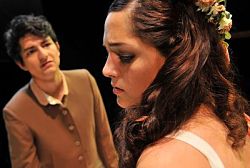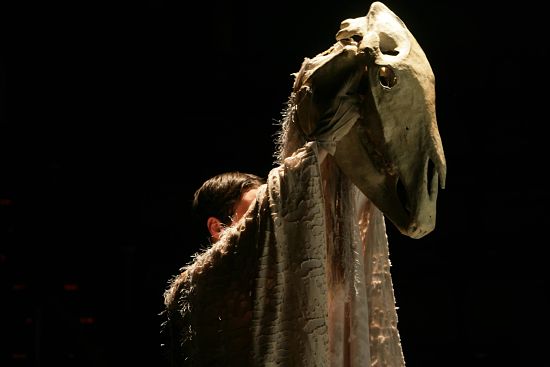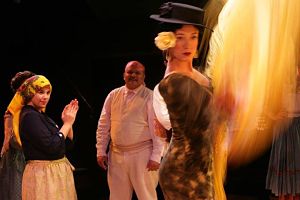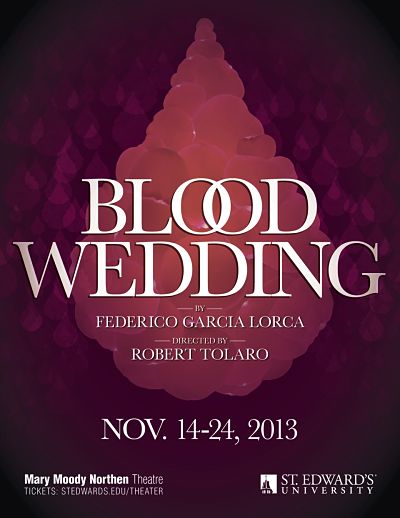Review: Bodas de Sangre (Blood Wedding) by Mary Moody Northen Theatre
by Michael Meigs
Federico García Lorca's Bodas de Sangre takes places in the stark and arid landscape of the mind. The setting is rural Spain, somewhere far out in the countryside, and the characters are peasant families. They have no names, with the single exception of Leonardo, the angry and frustrated young farmer who precipitates the tragedy.
García Lorca identifies the others by role: the intended groom (novio), the bride (novia), the mother, the neighbor, the father of the bride. The story is simple: the confident young novio goes courting and fixes upon an eligible young woman related to men who killed his father and his brother. We watch the courting and attend the wedding; we also witness the anger of Leonardo, who still burns with a passion for the novia even though their acquaintance was broken years ago when Leonardo married the novia's cousin.
 Blood will have blood, despite all efforts to forget, to reconcile and to wash lives clean.
Blood will have blood, despite all efforts to forget, to reconcile and to wash lives clean.
García Lorca had already achieved renown as a lyric poet when this, his first great success, was staged in Madrid for the first time in 1933. He doesn't fill these characters' mouths with abstractions or self-indulgent speculations, however; dialogue in the first half of the play is quick, sentences are short, and speech is often staccato. The early dialogue is sharp and cutting, much like the "little knife" that the novio's mother laments -- "a knife is such a simple object but it can take away the life of a man."
Contrasting with this energy are songs with imagery as lyrical as any of the author's poetry. In the second scene, Leonardo's wife and mother-in-law sing a cryptic lullabye about a mythic horse that refuses to drink; during the act two wedding preparations both servants and guests join in song, each offering a line or couplet.

Disaster is revealed late in act two and the wedding is interrupted. The tragic events of act three are heightened by songs from the personified Moon and by a beggar woman symbolizing death. The tone has shifted. The fleeing couple that appears in this highly charged setting address one another in verse , subtly metrical in Lorca's singing Spanish original; less melodic but still strong in the standard Lujan-O'Connell translation from 1941.
For example:
| García Lorca's original | Translation, Graham-Lujan and O'Connell |
|---|---|
| ¡Qué vidrios se me clavan en la lengua! Porque yo quise olvidar y puse un muro de piedra entre tu casa y la mia. Es verdad. ¿No lo recuerdas? Y cuando te vi de lejos me eché en los ojos arena. Pero montaba a caballo Y el caballo iba a tu puerta. Con alfileres de plata mi sangre se puso negra, y el sueño me fue llenando las carnes de mala hierba. Que yo no tengo la culpa, que la culpa es de la tierra y de ese olor que te sale de los pechos y las trenzas. |
What glass splinters are stuck in my tongue! Because I tried to forget you and put a wall of stone between your house and mine. It's true. You remember? And when I saw you in the distance I threw sand in my eyes. But I was riding a horse and the horse went straight to your door. And the silver pins of your wedding turned my red blood black. And in me our dream was choking my flesh with its poisoned weeds. Oh, it isn't my fault -- the fault is the earth's -- and this fragrance that you exhale from your breasts and your braids. |
Even in this short passage, taken at random from the third act, the translation contains errors and distortions. Lorca's Spanish sings; the translation is awkwardly literal.
 But this production regains much of the lyricism, thanks to Director Robert Tolaro's staging and concept. Few of us English speakers know much about Spain, but we do recognize the ardently dramatic flamenco music style.
But this production regains much of the lyricism, thanks to Director Robert Tolaro's staging and concept. Few of us English speakers know much about Spain, but we do recognize the ardently dramatic flamenco music style.
With movement assistance from Pilar Andújar and the compositions of the four young classical guitarists seated in an upper corner of the theatre to accompany throughout the piece, Tolaro uses music, dance and mime to situate this intentionally non-localized action in or near Granada in southern Spain. Hannah Marie Fonder moves silently and intently among the talkative characters, appearing as a flamenco dancer, animating a startlingly menace horse puppet, and symbolizing Death in the form of the beggar woman.
It's a beautiful, gripping and highly effective staging.
 García Lorca's story is to some extent an abstraction -- not an idealization -- of the feminine and an exploration of the fate of women. Babs George as the deeply resentful, suspicious and fretful mother of the novio is is the garrulous older woman betrayed by life; the novia (Anna Schultz) is ripeness, hope and potential passion; and Leonardo's wife (Vanessa Marroquin) is the dutifully submissive but uncertain wife.
García Lorca's story is to some extent an abstraction -- not an idealization -- of the feminine and an exploration of the fate of women. Babs George as the deeply resentful, suspicious and fretful mother of the novio is is the garrulous older woman betrayed by life; the novia (Anna Schultz) is ripeness, hope and potential passion; and Leonardo's wife (Vanessa Marroquin) is the dutifully submissive but uncertain wife.
The men in the story are peripheral to this triangle. Alec Esteban Cudmore is tall, confident and stalwart as the novio; J. Ben Wolfe is the determinedly jovial father of the novia, intent on reassuring the novio's mother. Jose Antonio Rodriguez as Leonardo, the only named character, plays the outsider as generally petulant.
García Lorca was a native of the Granada region and remained deeply attached to its traditions despite triumphs in Madrid and Buenos Aires and a lengthy stay in New York. He developed rapidly as a dramatist, completing his second major work Yerma a year later (Texas State University is staging that work this weekend). In June of 1936 he gave a reading of the third, La Casa de Bernarda Alba, for an aristocratic audience in Madrid, shortly before returning for the summer to Granada, where his brother-in-law was the Socialist mayor of the city.
In July the Spanish Civil War broke out ad the conservative military garrison rose against the leftist administration. They seized and executed the mayor in early August, and arrested García Lorca. The poet was executed sometime in mid-August and his remains have never been located.
Blood will have blood, despite all efforts to forget, to reconcile and to wash lives clean.
Bodas de Sangre (Blood Wedding)
by Federico García Lorca
Mary Moody Northen Theatre
